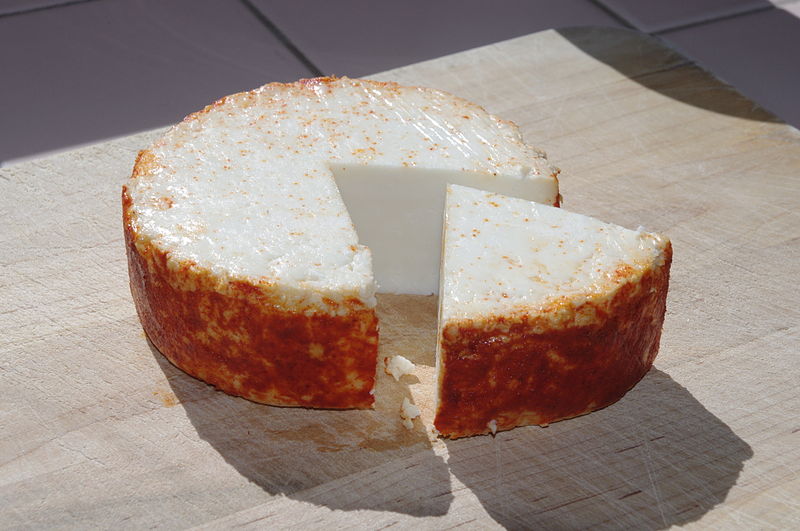Cotija Cheese
What is Cotija Cheese and How To Pronounce 'Cotija'?
Cotija cheese is a popular Mexican cheese known for its distinctive taste and crumbly texture. Cotija can be difficult for some English speakers to pronounce - the proper pronunciation is "koh-TEE-hah...
Cotija In English
Cotija does not have a direct English translation, as the name's origin comes from the town where the cheese originates from....
What is Cotija Cheese Made of?
Cotija Cheese is made from raw cow's milk. Cotija cheese is crafted by local artisans in Cotija, Mexico, who follow traditional methods passed down through generations. The process of making Cotija Ch...
Where Is Cotija Cheese From?
Cotija cheese is from the town of Cotija, Michoacán, in Mexico. Cotija has been produced for centuries and is deeply ingrained in the local culinary traditions. The town of Cotija is famous for its tr...
What Does Cotija Taste Like? What is Cotija's Flavor?
Cotija cheese has a bold and salty flavor, and is white in color and firm in texture. Cotija has a slightly tangy and nutty taste, with a hint of sweetness. It has been compared to Feta cheese by some...
Substitutes for Cotija Cheese
Cotija is a firm, crumbly Mexican cheese often used as a topping or garnish. If you can't find Cotija, suitable substitutes here on Cotija's substitutes page!...
The Distinctive Characteristics of Cotija Cheese
When young, it is white, fresh and salty, thus bearing immense resemblance to feta cheese. However, with aging, it becomes hard and crumbly like Parmigiano-Reggiano. Its similarity with Parmesan has e...
Is Cotija Cheese Healthy to Eat?
Cotija is rich in calcium, which is found to be good for your bones' health in preventing osteoporosis and even strengthens the hard outer shell of your teeth's enamel (to defend against erosion and c...
The Health Benefits of Cotija Cheese
While Cotija cheese should be enjoyed in moderation, it can offer some health benefits....
What is the Nutritional Information for Cotija Cheese?
In general, a 1-ounce (28 grams) serving typically provides:...
How to Use Cotija Cheese
Cotija cheese is incredibly versatile, lending itself to a variety of culinary applications. Whether grated over tacos, enchiladas, soups, and salads, crumbled onto roasted vegetables, grilled meats, ...
Creative Recipes Featuring Cotija Cheese
Take your culinary adventures to the next level by incorporating Cotija cheese in these creative recipes:...
What To Pair With Cotija Cheese
Foods Pairings for Cotija Cheese
Given its strong, salty flavor, Cotija cheese pairs well with a variety of foods. It's often used in Mexican cuisine, where it's crumbled over dishes like tacos, enchiladas, and elote (Mexican street ...
How to Pair Cotija Cheese With Beverages
When it comes to beverages, Cotija cheese pairs well with a variety of wines and beers. Light-bodied white wines like Sauvignon Blanc or Pinot Grigio can balance the cheese's saltiness, while robust r...
Search Cheese Retailers
Shops that sell this cheeseShowing 0 out of 0 results

Over 200,000 page views per month, Put your store on our map!
Contact UsOther cheeses from Mexico:
Discover the best substitutes and alternatives for Cotija cheese to add a delicious twist to your dishes.
Cotija Cheese Substitutes and Alternatives
Queso Fresco, Feta and Panela are great substitutes for Cotija cheese but there are a few considerations that you can read further here below.
Cotija cheese is a …
Read MoreCotija Cheese Q & A
-
Is Cotija Lactose-Free?
Cotija cheese, like most cheeses, contains lactose. However, the aging process of Cotija cheese reduces the lactose content, making …
Read More -
Is Cotija Vegetarian?
Cotija cheese is not strictly vegetarian.
Traditional Cotija cheese is made using animal rennet, which is derived from the …
Read More -
Is Cotija Cheese Gluten-Free?
Great news for those who follow a gluten-free diet: Cotija cheese is indeed gluten-free!
Made from cow's milk, salt, …
Read More -
How Long Does Cotija Cheese Last?
Generally, when properly refrigerated, an unopened block of Cotija cheese can last for up to 2-3 months. The shelf …
Read More -
How to Store and Preserve Cotija Cheese?
Once opened, tightly wrap the remaining portion of the cheese in plastic wrap or aluminium foil to prevent moisture …
Read More -
Can I Freeze Cotija Cheese?
While freezing Cotija cheese is possible, it is not recommended - for the sake of preserving the intended flavor …
Read More -
Can My Dog Eat Cotija Cheese?
When it comes to dogs, moderation is key. Cotija cheese can be a tasty treat for your furry friend …
Read More -
Can My Cat Eat Cotija Cheese?
While cotija cheese is not toxic to cats, however, it is generally not recommended to feed it to …
Read More -
Can I Eat Cotija Cheese When Pregnant?
The good news is that most types of Cotija cheese are made from pasteurized milk, which reduces the risk …
Read More -
Does Cotija Cheese Melt?
Cotija cheese is not typically a melting cheese.
Cotija cheese slightly softens when heated, but it doesn't melt or …
Read More






